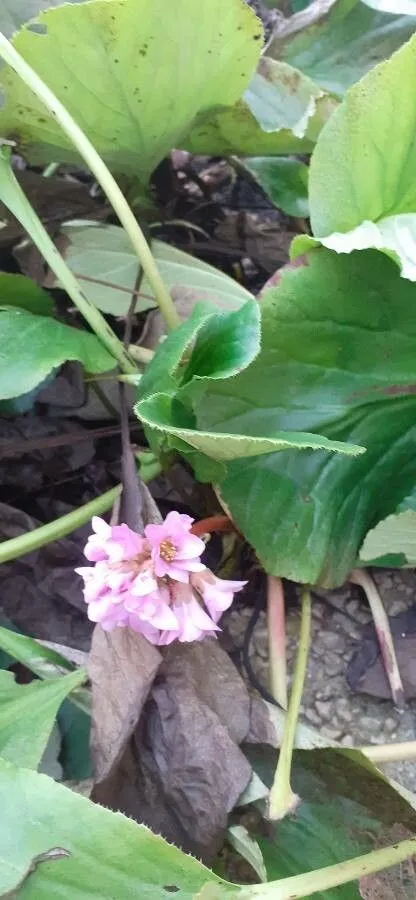
Author: (L.) Fritsch
Bibliography: Verh. Zool.-Bot. Ges. Wien 39: 587 (1889)
Year: 1889
Status: accepted
Rank: species
Genus: Bergenia
Vegetable: False
Observations: Siberia to N. Korea
Siberian-tea, scientifically known as Bergenia crassifolia, is a remarkable plant that highlights the intricate beauty of the Saxifragaceae family. Recognized for its resilience and adaptability, this perennial herbaceous plant thrives in a wide geographical range, extending from the harsh terrains of Siberia to the diverse landscapes of Northern Korea.
Bergenia crassifolia is a robust and hardy plant, often admired for its thick, leathery leaves which display a stunning transformation throughout the seasons. In the spring and summer, the leaves exhibit a rich green hue, eventually transitioning into a deep burgundy or bronze as the cooler months approach. This seasonal color change not only adds aesthetic value to gardens but also reflects the plant’s adaptability to varying climatic conditions.
This elegant plant is also noted for its clusters of bell-shaped flowers that typically bloom in late spring. The flowers, ranging from delicate shades of pink to vibrant purples, rise gracefully on sturdy stems above the foliage, attracting pollinators such as bees and butterflies. The blooming period not only enhances the visual appeal of gardens and natural landscapes but also plays a vital role in supporting local ecosystems.
Historically, Bergenia crassifolia has been utilized beyond ornamental purposes. In traditional medicine, particularly in its native regions, the leaves and roots have been used for their purported health benefits. Nowadays, its dried leaves are commonly brewed into a herbal tea, known as Siberian-tea, cherished for its soothing properties and unique flavor.
Botanically characterized in 1889 in Verh. Zool.-Bot. Ges. Wien by (L.) Fritsch, this plant has continued to captivate botanists and plant enthusiasts alike. Its enduring popularity is a testament to its versatile beauty and practical applications in horticulture and traditional practices.
In summary, Siberian-tea (Bergenia crassifolia) stands out as a testament to nature’s artistry and utility. Its striking foliage, charming flowers, and historical significance make it a valuable addition to gardens, while its resilience and adaptability ensure it remains a staple in various climatic regions.
Fra: bergenia
Deu: bergenie, dickblatt-bergenie, dickblättrige bergenie, dicke bergenie
Eng: elephant-ears, siberian-tea
Lit: storalapė bergenija
Dan: tykbladet kæmpestenbræk
Swe: bergenia, hjärtbergenia, vinterblad
Ces: bergenie tu
Por: chá-da-sibéria
Cym: clustiau eliffant
En: Siberian-tea, Elephant-ears
Ar: برغنية سميكة الأوراق
Az: Qalınyarpaq bergeniya
Be: Бадан таўсталісты
Zh: 厚叶岩白菜, 青海白菜
Hr: Slonovo uho (kamenikovke)
Cs: Bergenie tučnolistá, Bergenie tu
Da: Tykbladet kæmpestenbræk
Et: Kaheleheline bergeenia
Fi: Herttavuorenkilpi, Soikkovuorenkilpi
Fr: Bergenia, Bergénie à feuilles charnues, Oreille-d’éléphant
De: Altai-Herzblatt-Bergenie, Dickblatt-Bergenie, Herzblättrige Bergenie, Bergenie, Dickblättrige Bergenie, Dicke Bergenie
It: Bergenia
Kk: Etjapıraq badan, Етжапырақ бадан, ەتجاپىراق بادان
Lv: Biezlapu bergēnija
Lt: Storalapė bergenija
Fa: گل برگنیا
Pt: Chá-da-sibéria
Ru: Бадан толстолистный
Sk: Bergénia tučnolistá
Sv: Bergenia, Hjärtbergenia, Vinterblad
Zh-tw: 青海白菜
Tt: Каты яфраклы чагыр
Zh-hant: 青海白菜
Cy: Clustiau eliffant
Taken Mar 23, 2018 by Pep Secem (cc-by-sa)
Taken Mar 13, 2018 by Pep Secem (cc-by-sa)
Taken Mar 13, 2018 by Pep Secem (cc-by-sa)
Taken Dec 18, 2021 by Manuel Madrid (cc-by-sa)
Taken Dec 23, 2018 by Dieter Wagner (cc-by-sa)
Taken Jan 15, 2022 by Caroline Champigny (cc-by-sa)
Taken Nov 26, 2019 by Dieter Wagner (cc-by-sa)
Taken Apr 2, 2022 by Joseph Dupont (cc-by-sa)
Taken Nov 27, 2021 by Jacques Zuber (cc-by-sa)
Taken Nov 26, 2019 by Dieter Wagner (cc-by-sa)
Taken Mar 5, 2019 by Manu Pacha (cc-by-sa)
Taken Feb 18, 2022 by Bernard Lucas (cc-by-sa)
Taken Feb 24, 2020 by julia juli (cc-by-sa)
Taken Mar 5, 2019 by Manu Pacha (cc-by-sa)
Taken Feb 24, 2020 by julia juli (cc-by-sa)
© copyright of the Board of Trustees of the Royal Botanic Gardens, Kew.
© copyright of the Board of Trustees of the Royal Botanic Gardens, Kew.
© copyright of the Board of Trustees of the Royal Botanic Gardens, Kew.
Taken Dec 21, 2020 by Dieter Wagner (cc-by-sa)
Taken Mar 14, 2022 by huy HO (cc-by-sa)
Taken Dec 23, 2018 by Dieter Wagner (cc-by-sa)
Taken Dec 23, 2018 by Dieter Wagner (cc-by-sa)
Taken Dec 23, 2018 by Dieter Wagner (cc-by-sa)
Taken Apr 2, 2022 by Felfoul Boualem (cc-by-sa)
Taken Apr 10, 2021 by Dieter Albrecht (cc-by-sa)
Taken Nov 23, 2020 by stefania canale (cc-by-sa)
Taken Sep 14, 2021 by Raffaella D’Ambra (cc-by-sa)
Taken Nov 30, 2022 by Fabrice Rubio (cc-by-sa)
Taken Jan 24, 2022 by David Scott (cc-by-sa)
Taken May 9, 2021 by sous les tilleuls (cc-by-sa)
Taken Aug 27, 2019 by Bernd Sauerwein (cc-by-sa)
Taken Apr 9, 2021 by Vanessa T (cc-by-sa)
Taken Apr 28, 2018 by jgm Wijnans (cc-by-sa)
Family: Myrtaceae Author: (F.Muell.) K.D.Hill & L.A.S.Johnson Bibliography: Telopea 6: 402 (1995) Year: 1995 Status:…
Family: Rubiaceae Author: Pierre ex A.Froehner Bibliography: Notizbl. Bot. Gart. Berlin-Dahlem 1: 237 (1897) Year:…
Family: Sapindaceae Author: Koidz. Bibliography: J. Coll. Sci. Imp. Univ. Tokyo 32(1): 38 (1911) Year:…
Family: Asteraceae Author: A.Gray Bibliography: Pacif. Railr. Rep.: 107 (1857) Year: 1857 Status: accepted Rank:…
Family: Fabaceae Author: Medik. Bibliography: Vorles. Churpfälz. Phys.-Ökon. Ges. 2: 398 (1787) Year: 1787 Status:…
Family: Aspleniaceae Author: (Cav.) Alston Bibliography: Bull. Misc. Inform. Kew 1932: 309 (1932) Year: 1932…